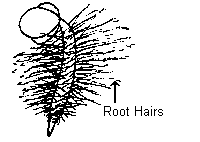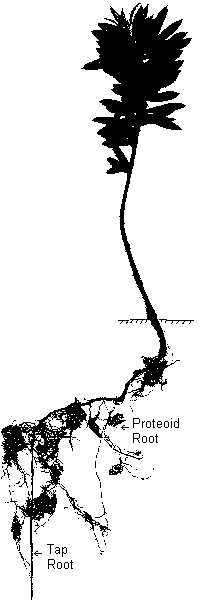
Home
Mission
Overview of Project
Project Staff
Sponsors
Achievements
Checking, Illustrations
Upcoming Activities
Id and Species Lists
Protea Information
Protea Gallery
Growing Proteas
Interim Dist. Maps
Publications
Afrikaanse Inligting
![]()
Phloeonomus looks at Proteoid Roots
| "Roots are very important for plants. They are anchors which stop the plant from being blown away by the wind. But their most important job is being the pipeline between water in the soil and leaves which use sunshine to make food. At the same time roots must look for minerals and elements so that the plant can make its food. |  |
An underground water pipe: that's not good
enough! It's OK if the plant is sitting on top of lots of water.
But when things dry out the roots must "suck" water out
of the soil. To do this a plant needs very fine
"fingers" to capture water held onto the grains of
soil: these fingers are called root hairs. If you sow a radish
seed in a dish (covered with tissue paper) you can easily see the
root hairs near the root tip.
Not all plants have root hairs. Oak trees,
Eucalypts and Ericas do not ..."
Phloeonomus jerked to attention. Visiting Trichos, the Protea Beetle Grub, for tea was usually interesting, but he did tend to lecture about the most boring things. Always he went on for hours - Melissa Meloid Beetle (the one who gives you blisters if you touch her) says he sometimes goes on for days, even after everyone has gone home! Phloeonomus could not contain himself, even though Trichos hated to be disturbed.
"If they don't have root hairs they cannot get water! So why don't they frizzle up and die?"
Trichos glared! His little eye-spots seemed to bore through
Phloeonomus, but he carried on talking as if he had not heard
anything.
"... These plants use fungi - yes mushrooms! - to get the water for them. Fungi have long thin threads, much longer than any root hair can be! They search out the water, and in return the plants give them some food ..."
Phloeonomus was slowly dropping off to sleep again. "What about proteas?" he sighed, imagining his favourite protea head brimming with nectar and pollen and warm in the sun.
"Ah", said Trichos, "a very interesting question! Proteas live in very nutrient-poor soils - so there are very few minerals and elements to be had. That's why the first thing a baby protea does is grow its tap root deep down to where the ground water is. Then it has a lifetime supply of water. All the slowpoke proteas who do not reach water by summer will frizzle in the sun and die."
"What has that got to do with nutrient-poor soils?" thought Phloeonomus, licking his lips at the thought of a nice long nectar drink.
"Proteas have special roots, which look like bottle-brushes, to get the minerals and elements from the soil. These "proteoid roots" are covered with root hairs. They are very efficient at soaking up minerals and elements. So much so that they may take up amounts enough to kill the plant! But that only happens when some silly gardener uses a fertilizer with too much potassium in it. In nature proteoid roots only grow near the top of the soil - that's where the dead leaves die and release their minerals. Because leaves decay fastest in spring (when its not too cold or too dry) proteoid roots form mainly in spring. Proteoid roots are seldom found in baby plants - they still have enough of the minerals mummy gave them in the seed leaves. Proteoid roots are seldom found in plants growing in fertile soils - they can get enough minerals without proteoid roots. But in nutrient-poor soils in spring, the proteoid roots may account for 80 per cent of the total root mass in a protea plant. From this you can see how important catching minerals and elements is to a protea.
"Ah", thought Phloeonomus, "the tap roots get the water to make my nectar, and the proteoid roots get the minerals to make my pollen. I think it must be supper time! Bye!"
Back Phloeonumus Corner